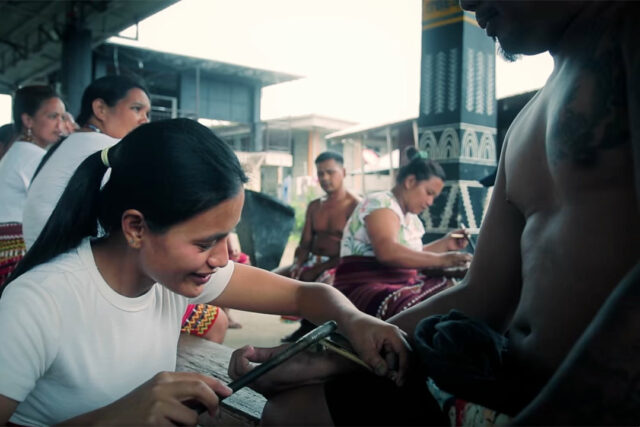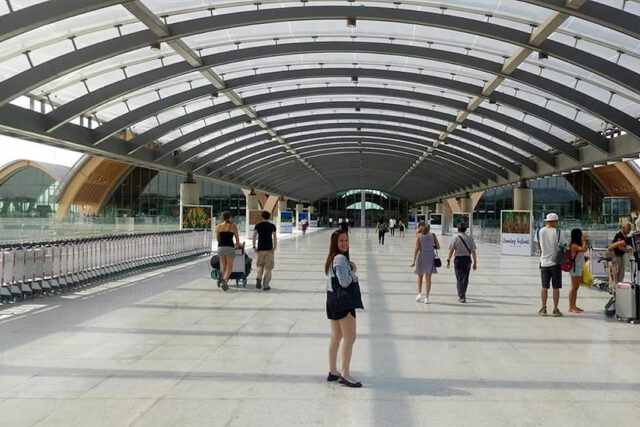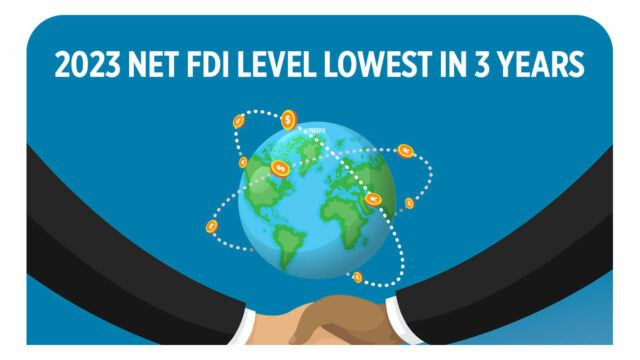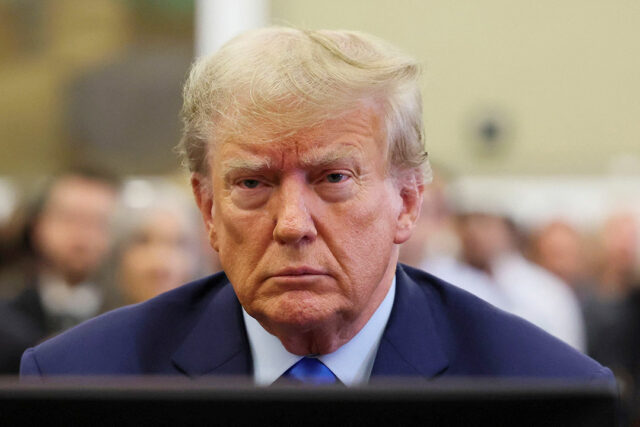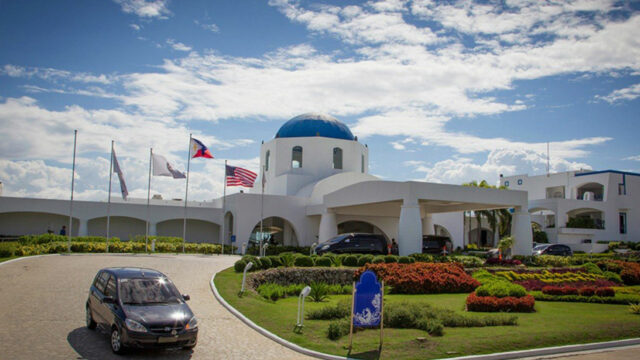A phenomenon is simply any observable event that spans a specific timeline, usually linear, a forward trajectory with the benefit of hindsight. From this perspective, a social phenomenon is said to be a product of people’s interactions, of cultural convergences, and of expectations and realities, at various moments aggregated in the now. Change is embedded in any phenomenon.
Buscalan was like any sleepy community in the rugged mountains of Kalinga. More than a decade ago, one would have had to trek for about three hours — climbing from Bugnay, walking on dusty roads for what seems to be an eternity under the heat of the sun, passing through a school and a military camp. Then came the walk by the side of the mountain, a very thin walking path for a few kilometers, then passing a death-defying cement hanging bridge with invisible pillars — you either walked with eyes focused on the other side or simply crawled, holding on to dear life. Several more kilometers and you’d reach a small field and makeshift dirt stairs with nothing to hold on to but sharp grass. Finally, you’d see a house, smoke coming from a chimney-like cylinder. And, yes, coffee — the smell of coffee all over. This was 2011.
My son and I were met by Whang-Od, the legendary last mambabatok (a.k.a. hand tapped tattoos) and young Grace Palicas, her apprentice, who was around 14 years old at that time. We were welcomed in Whang-Od’s home, surrounded by small native black pigs running around, and rice and beans cooking in pots over fire. We exchanged stories — primarily sharing where we were from and Whang-Od sharing how she became a mambabatok during her younger years, much like how Grace was at that time. And thus, this was where it all began, my passion to understand the story of Buscalan, an autoethnographic journey.
BUSCALAN WOMEN AND CONFLICT
Armed conflict came to the Cordillera with the expansion of the Communist Party of the Philippines-New People’s Army (CPP-NPA) into the region. Specifically, to struggle against development aggression in the form of mining (by the Batong Buhay Gold Mining Project in Kalinga), dam-building (the Chico River Dam Project in Kalinga and Mountain Province), and logging (by the Cellophil Resources Corp. in Abra) that threatened the ancestral lands and resources of the Cordillerans. Initially, joining the CPP-NPA provided the force with which to go against the government. However, a rift would soon materialize since the Cordillera decided to fight for their right of self-determination in contrast to the national democratic aim and ideological anchor of the CPP-NPA. Eventually, the CPP helped establish the Cordillera People’s Democratic Front (CPDF) which was led by former Catholic priest and Tingguian tribe member, Conrado Balweg.
The narratives of conflict of the Buscalan women who shared their stories spanned from the Martial Law period all the way to the death of Balweg in 1999. These women lived through armed encounters between the military and the NPA, and between the NPA and the Cordillera People’s Liberation Army (CPLA), the successor of the CPDF.
The women were very emphatic and animated when they shared their experiences of militarization during Martial Law. Most of them said that the military forcibly took the pigs that they owned and slaughtered their property in front of them. The women’s most tumultuous experience was in the mid-1980s, after the split of the CPLA from the NPA. As the women of Buscalan recalled, just as they were being threatened, their husbands — who were advised earlier to leave the community and hide elsewhere — were found by the NPA and were brought to another sub-tribe where they were allegedly disarmed, rounded-up, stripped naked, and tortured. The women and their children, on the other hand, were held hostage and had to endure shots fired by the NPA at rocks that ricocheted at them.
During tribal wars, women were said to be the ones to bring food and other necessities to the men preparing for battle or guarding their tribal boundaries. This role was a huge challenge for women because they had to risk their lives twice every time — when they’d gather food in the fields and when they’d deliver the food to their men on the battlefield. To de-escalate the conflict, tribes engaged in peace pacts or bodong, usually held by men.
EVOLVING REACTIONARY TRANSACTIONAL COMMUNITY ECONOMY: CENTRALITY OF WOMEN’S WORK
Those coming to and leaving Buscalan now will rarely hear these stories. Maybe because their interest is focused only on getting tattoos from Whang-Od and Grace.
As I visited the community several more times in a span of 13 years, I observed the transformation of Buscalan as a community and women in their new roles. Previously, Buscalan relied on things tourists would bring, like matches, clothes, canned goods. There were those who did outreach programs like donating school supplies, medicines, and even a karaoke system. Women would basically plant rice in the fields, harvest and process coffee beans, and care for their families. Young girls would be on the sidelines observing Whang-Od and Grace while they did their batok. A few men would be there too, sharing stories about their community and about people visiting their place; most of them served as translators during conversations.
A few years later, another apprentice — Elyang Wigan — also became prominent as she, along with Grace, practiced the batok on skins of willing visitors, many of whom chose from a list of tattoo designs posted around the tattooing area. Most recently, over 100 artists — mostly women (along with one man and one of a different gender identity) — practice the batok. Walk around the community and all you would hear was the sound of hand tapping, harmonious and in synch — a symphony of tapping ink on skins. Women mambabatok, in comparison with those of other genders, are said to have a lighter tap and thus, are more in touch with the canvas of skin they are working on. Other women, most of whom who used to stay at home and cared for children, now own souvenir shops and cafes and also serve as tour guides to visitors who make their own way to Buscalan.
The community largely transformed as a reaction to the needs of people who come to the community. There is an abundance of home stays, tour operators bring in hordes of people, following the instructions of women maybahay (householders). Whang-Od is still the central figure — her face is seen on murals, shirts, mugs, etc. Grace and Elyang do their own thing too. But despite the multitude of mambabatok, only Whang-Od, Grace, and Elyang can batok their signature three-dots. Other mambabatoks can pretty much do all other pre-determined Kalinga designs in a fast-paced frenzy of reproduction. Most visitors come down from the Buscalan with identical hand tapped tattoos — a centipede, a phython, a compass, a serpent eagle, a fern, a prayer, a standing eagle, an arrowhead, the sun, the moon, the sun and moon, and a scorpion — but with varying self-defined symbolic meanings. As for the community, the transaction is their livelihood itself.
And this phenomenon is simply Buscalan, a community transformed by women.
Dr. Ma. Lourdes Veneracion is an associate professor at the Department of Political Science, Ateneo de Manila University and director of its Asia-Pacific Center for the Responsibility to Protect-Philippine Office. She is also currently the vice-president of the Philippine Political Science Association.
mlveneracion@ateneo.edu


